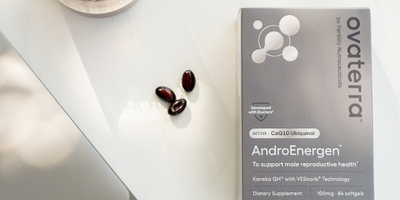A 2019 study that analyzed the Time to Conceive, a prospective cohort study of reproductive health biomarkers, found an interesting association between healthy Vitamin D levels and normal length of luteal phase of the menstrual cycle. Read on to learn what the findings in this study may mean for your reproductive health.
Key findings
- 1,278 menstrual cycles and Vitamin D levels of 446 healthy women women were examined. 5% of the women were Vitamin D deficient, defined as less than 20 ng/mL of 25-hydroxyvitamin D, or 25(OH)D. 69% were not outright deficient, but fell below the 40 ng/mL recommended by Dr. Bruce Hollis for reproductive health (and for general health, according to the Endocrine Task Force).
- Authors found that – even though a majority of women in the study had Vitamin D levels above the deficiency threshold – each 10 ng/mL decrease in the Vitamin D level was associated with a 30% higher chance of a long menstrual cycles. Other studies have connected longer menstrual cycles to anovulation.
- Lower Vitamin D levels were also associated with a higher likelihood of a short luteal phase (defined as less than 10 days when 12-14 days is typical). The risk of a short luteal phase increased sharply after the Vitamin D levels fell below approximately 30 ng/mL, with over 70% of women having a short luteal phase when their Vitamin D levels were below 10 ng/mL.
Follicular and luteal: Two phases of menstrual cycles
To understand the significance of the study’s findings, let’s review the two phases of a menstrual cycle. A menstrual cycle starts on the first day of the period. Follicular phase is the first part of the cycle, in which eggs go through the final maturation process toward ovulation.
The next phase of the menstrual cycle, the luteal phase, starts right after ovulation, when the egg, newly released from the ovarian follicle, starts traveling down the fallopian tube to eventually meet with the sperm, be fertilized and become an embryo. The end of the luteal phase is the start of the next menstrual period.
Why is the length of luteal phase important?
During luteal phase, the lining of the uterus thickens and new blood vessels form, in response to progesterone released from the empty follicle from which the egg has been released. This prepares the uterus for the embryo to implant.
When the luteal phase is short, the uterus may not have enough time to develop the endometrial lining to support a developing embryo. Thin endometrium and underdeveloped blood vessels can make implantation harder and pregnancy more difficult. The length of the luteal phase is not the only factor - key hormones have to be produced at the right moment, and the endometrium must respond to the hormones properly, too - but it's still an important factor in the health of the uterine environment.
What else is known about Vitamin D, ovulation and menstrual cycles?
Vitamin D, aside from its well-known role in bone health, has been suggested as possibly crucial in female reproductive health. For example, low Vitamin D levels have been reported as a potential risk factor for PCOS; studies have also suggested that normal levels of 25(OH)D (a biomarker of Vitamin D levels) may be associated with normal length and regularity of menstrual cycles.
How Vitamin D levels might influence luteal phase
Referring to animal studies that have suggested a connection between normally functioning Vitamin D receptors, normal cycle length and typical development of follicles, the study authors speculated that Vitamin D may paly a role in the hormonal regulation of the two phases of menstrual cycles. That said, why lower levels of Vitamin D, even within what’s considered the normal range, are associated with a short luteal phase isn’t clear. This is an area that requires more research to understand the mechanisms.
What it means for you and your reproductive health
Luteal phase is an important preparatory period for implantation and early pregnancy. While this study involved multiple assumptions about Vitamin D levels and had a heavily white, educated pool of participants, if the findings hold true in other studies, it may be a good idea to try to maintain Vitamin D levels above 40 ng/mL to support the luteal phase.
- If you are unsure about your Vitamin D levels are, ask your doctor to test your 25(OH)D – or try an at-home test to see where you are.
- Our primary source of Vitamin D is the synthesis that happens in the skin when exposed to sunlight (UV). Spend some time outside, during the day.
- There are some food sources of Vitamin D, including fortified milk and orange juice, eggs, salmon and some mushrooms.
- Vitamin D intake is particularly important during winter, when far more people are Vitamin D-deficient than in summer.
- Vitamin D supplements can also be an easy way to top up your levels, especially if you are at a higher risk of low levels.
As always, please reach out if any questions come up about Vitamin D, luteal phase and your reproductive health. We are with you.
Study vitals
- Title: Low 25-hydroxyvitamin D is associated with long menstrual cycles in a prospective cohort study
- Authors: Jukic AMZ, Wilcox AJ, McConnaughey DR, Weinberg CR, Steiner AZ
- Publication date: May 2019
- Journal: Epidemiology
- Study type: Prospective cohort study












